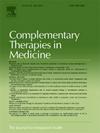Small-world network properties and cortical responses of Tai Chi Yunshou: Insights from fNIRS
IF 3.5
3区 医学
Q1 INTEGRATIVE & COMPLEMENTARY MEDICINE
引用次数: 0
Abstract
Objective
This study aims to characterize the time-domain features and functional network properties from Tai Chi Yunshou across four states (rest, observation, imagination, and motion) using functional near-infrared spectroscopy (fNIRS), thereby discriminating the neural mechanisms underlying the mental regulation and integrative body-mind harmony of Tai Chi Yunshou.
Methods
100 healthy participants were included and administered with rest, observation, imagination and motion states of Tai Chi Yunshou. The forty-channel wearable fNIRS system was utilized to evaluate the real-time cortical responses during four states. Brain network properties were analyzed with MATLAB and the GRETNA toolbox. Machine learning models, including random forest, AdaBoost, and gradient boosting, were applied for classification.
Results
Small-world network properties (γ>1 and λ≈1) across four states were detected. Compared to states of rest and observation, the motion state exhibited significantly higher γ, λ, Cp, and Eloc (P < 0.01). Additionally, λ and Cp were significantly greater in the motion state than that of the imagination state (P < 0.01). The motion state had increased betweenness centrality and nodal efficiency hubs of the dorsolateral prefrontal cortex and frontopolar area. Gradient boosting outperformed both AdaBoost and random forest across all evaluation metric.
Conclusion
The motion of Tai Chi Yunshou enhances regulatory capacity in the dorsolateral prefrontal cortex and frontopolar area, boosts local brain processing, and improves network integration. Machine learning models can effectively capture and differentiate the neural features between mental regulation and integrative body-mind harmony.
小世界网络特性与太极拳云手皮层反应:来自近红外光谱的观察。
目的:利用功能近红外光谱(fNIRS)研究太极拳云手在休息、观察、想象和运动四种状态下的时域特征和功能网络特性,从而鉴别太极拳云手心理调节和身心综合和谐的神经机制。方法:选取100名健康受试者,进行休息状态、观察状态、想象状态和太极拳运拳运动状态的研究。采用40通道可穿戴fNIRS系统评估四种状态下大脑皮层的实时反应。利用MATLAB和GRETNA工具箱对脑网络特性进行了分析。采用随机森林、AdaBoost和梯度增强等机器学习模型进行分类。结果:检测到四种状态下的小世界网络特性(γ>1和λ≈1)。运动状态下的γ、λ、Cp和Eloc显著高于静止状态和观察状态(P< 0.01)。运动状态下的λ和Cp显著高于想象状态(P< 0.01)。运动状态增加了背外侧前额皮质和额极区的中间性、中心性和节效率中枢。梯度增强在所有评估指标上都优于AdaBoost和随机森林。结论:太极拳云手运动增强了背外侧前额叶皮层和额极区的调节能力,促进了局部脑加工,改善了网络整合。机器学习模型可以有效地捕捉和区分心理调节和综合身心和谐之间的神经特征。
本文章由计算机程序翻译,如有差异,请以英文原文为准。
求助全文
约1分钟内获得全文
求助全文
来源期刊

Complementary therapies in medicine
医学-全科医学与补充医学
CiteScore
8.60
自引率
2.80%
发文量
101
审稿时长
112 days
期刊介绍:
Complementary Therapies in Medicine is an international, peer-reviewed journal that has considerable appeal to anyone who seeks objective and critical information on complementary therapies or who wishes to deepen their understanding of these approaches. It will be of particular interest to healthcare practitioners including family practitioners, complementary therapists, nurses, and physiotherapists; to academics including social scientists and CAM researchers; to healthcare managers; and to patients. Complementary Therapies in Medicine aims to publish valid, relevant and rigorous research and serious discussion articles with the main purpose of improving healthcare.
 求助内容:
求助内容: 应助结果提醒方式:
应助结果提醒方式:


